Biomass—renewable energy from plants and animals
Biomass is renewable organic material that comes from plants and animals. Biomass was the largest source of total annual U.S. energy consumption until the mid-1800s. Biomass continues to be an important fuel in many countries, especially for cooking and heating in developing countries. The use of biomass fuels for transportation and for electricity generation is increasing in many developed countries as a means of avoiding carbon dioxide emissions from fossil fuel use. In 2023, biomass provided nearly 5% of total primary energy use in the United States.
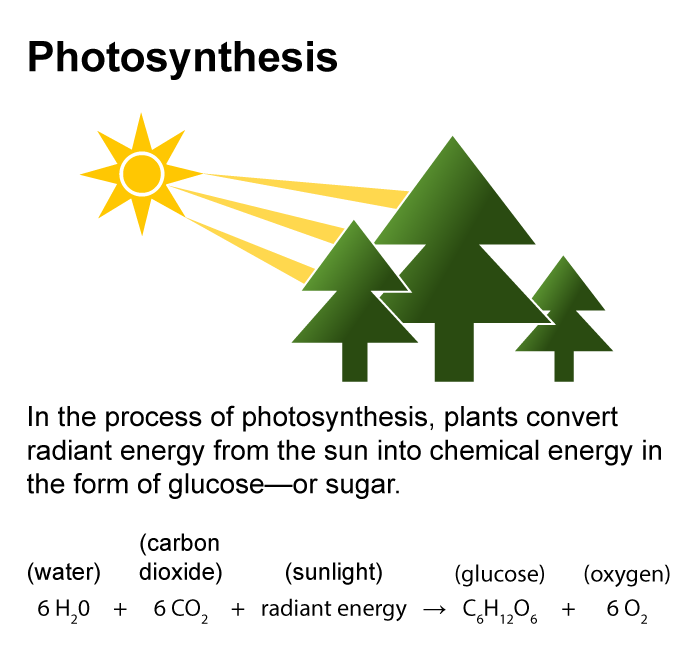
Data source: Adapted from The National Energy Education Project (public domain)
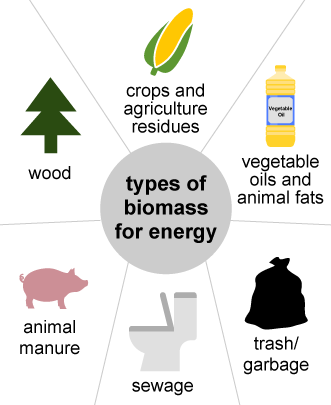
Data source: U.S. Energy Information Administration (public domain)
Biomass contains stored chemical energy from the sun. Plants produce biomass through photosynthesis. Biomass can be burned directly for heat or converted to renewable liquid and gaseous fuels through various processes.
Biomass sources for energy include
- Wood and wood processing wastes—firewood, wood pellets, and wood chips, lumber and furniture mill sawdust and waste, and black liquor from pulp and paper mills
- Agricultural crops and waste materials—corn, soybeans, sugar cane, switchgrass, woody plants, and algae, and crop and food processing residues
- Biogenic materials in municipal solid waste—paper, cotton, and wool products, and food, yard, and wood wastes
- Animal manure and human sewage
Converting biomass to energy
Biomass is converted to energy through various processes, including:
- Direct combustion (burning) to produce heat
- Thermochemical conversion to produce solid, gaseous, and liquid fuels
- Chemical conversion to produce liquid fuels
- Biological conversion to produce liquid and gaseous fuels
Direct combustion is the most common method for converting biomass to useful energy. All biomass can be burned directly for heating buildings and water, for industrial process heat, and for generating electricity in steam turbines.
Thermochemical conversion of biomass includes pyrolysis and gasification. Both are thermal decomposition processes in which biomass feedstock materials are heated in closed, pressurized vessels called gassifiers at high temperatures. They mainly differ in the process temperatures and amount of oxygen present during the conversion process.
- Pyrolysis entails heating organic materials to 800–900oF (400–500 oC) in the near complete absence of free oxygen. Biomass pyrolysis produces fuels such as charcoal, bio-oil, renewable diesel, methane, and hydrogen.
- Hydrotreating is used to process bio-oil (produced by fast pyrolysis) with hydrogen under elevated temperatures and pressures in the presence of a catalyst to produce renewable diesel, renewable gasoline, and renewable jet fuel.
- Gasification entails heating organic materials to 1,400–1700oF (800–900oC) with injections of controlled amounts of free oxygen and/or steam into the vessel to produce a carbon monoxide and hydrogen rich gas called synthesis gas or syngas. Syngas can be used as a fuel for diesel engines, for heating, and for generating electricity in gas turbines. It can also be treated to separate the hydrogen from the gas, and the hydrogen can be burned or used in fuel cells. The syngas can be further processed to produce liquid fuels using the Fischer–Tropsch process.
A chemical conversion process known as transesterification is used for converting vegetable oils, animal fats, and greases into fatty acid methyl esters (FAME), which are used to produce biodiesel.
Biological conversion includes fermentation to convert biomass into ethanol and anaerobic digestion to produce renewable natural gas. Ethanol is used as a vehicle fuel. Renewable natural gas—also called biogas or biomethane—is produced in anaerobic digesters at sewage treatment plants and at dairy and livestock operations. It also forms in and may be captured from solid waste landfills. Properly treated renewable natural gas has the same uses as fossil fuel natural gas.
Researchers are working on ways to improve these methods and to develop other ways to convert and use more biomass for energy.
Biomass provided about 5% of U.S. energy in 2023
In 2023, biomass accounted for 5% of total U.S. primary energy consumption, equal to about 4,978 trillion British thermal units (TBtu) (or 4.9 quadrillion Btu). The types, amounts, and the percentage shares of total biomass energy consumption in 2023 were:
- Biofuels—2,662 TBtu—53%
- Wood and wood waste—1,918 TBtu—39%
- Municipal solid waste, animal manure, and sewage—398 TBtu—8%
The industrial sector is the largest consumer of biomass for energy in the United States
The amounts—in TBtu—and percentage shares of total U.S. biomass energy use by consuming sector in 2023 were:
- Industrial—2,225 TBtu—45%
- Transportation—1,788 TBtu—36%
- Residential—450 TBtu—9%
- Electric power—329 TBtu—7%
- Commercial—185 TBtu—4%
The industrial sector account for the largest amounts, in terms of energy content, and largest percentage shares of total annual U.S. biomass consumption. The wood products and paper industries use biomass in combined heat and power plants for process heat and to generate electricity for their own use. Liquid biofuels (ethanol and biomass-based diesel) account for most of the transportation sector's biomass consumption.
The transportation sector accounted for the second-highest amount and percentage share of biomass (as biofuels) consumption in 2023.
The residential and commercial sectors use firewood and wood pellets for heating. The commercial sector also consumes, and in some cases, sells renewable natural gas produced at municipal sewage treatment facilities and at waste landfills.
The electric power sector uses wood and biomass-derived wastes to generate electricity for sale to the other sectors.
The United States is a net exporter of biomass energy
On an energy content basis, U.S. total biomass energy exports exceeded total biomass energy imports in 2023.
Densified biomass fuels (wood pellets and other densified biomass fuels) have become a U.S. export product in recent years. In 2023, the United States exported about 8.6 million tons of wood fuel pellets (Table 8).
Wood & wood waste
Biomass—Wood and wood waste
People have used wood for cooking, heating, and lighting for thousands of years. Wood was the main source of energy for the United States and the rest of the world until the mid-1800s. Wood continues to be an important fuel in many countries, especially for cooking and heating in developing countries.
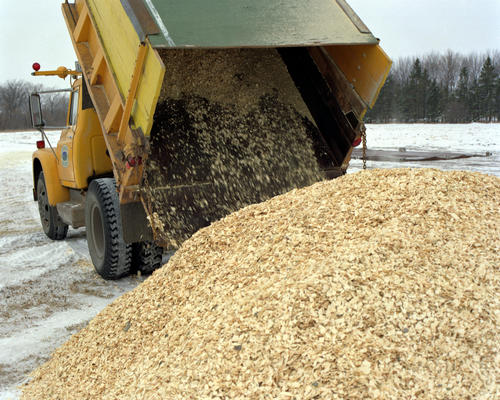
Data source: National Renewable Energy Laboratory, U.S. Department of Energy (public domain)
In 2023, about 2.1% of total U.S. annual energy consumption was from wood and wood waste—bark, sawdust, wood chips, wood scrap, and paper mill residues.
Using wood and wood waste
Industry accounts for most wood and wood-waste fuel consumption in the United States. The top industrial users are wood product and paper manufacturers. They use lumber mill and paper mill waste to produce steam and electricity, which saves money because it reduces the amount of other fuels and electricity they must purchase to operate their facilities. In 2023, the industrial sector accounted for about 64% of total U.S. consumption of wood and wood waste. Wood and wood waste also accounted for about 8.5% of industrial sector end-use energy consumption and 7.2% of total industrial sector energy consumption.1
The residential sector is the second-largest user of wood for energy in United States. Wood is used in homes throughout the United States for heating as cord wood in fireplaces and wood-burning appliances, and as pellets in pellet stoves. In 2023, wood energy accounted for about 4.0% of residential sector end-use energy consumption and 2.4% of total residential energy consumption. In 2020, 8.9% of all U.S households (about 11 million) used wood for energy (mostly for space heating). About 2.2 million households used wood as the main space-heating fuel.
In the electric power sector, there are several power plants that burn mostly wood to generate electricity, and some coal-burning power plants burn wood chips with coal to reduce sulfur dioxide emissions. Most of the commercial sector's use of wood is for heating.
- Wood and wood waste energy consumption by energy-consuming sectors—in trillion British thermal units (TBtu)—and their percentage shares of total U.S. wood and wood waste energy consumption in 2023 were:
- industrial1,278 TBtu61%
- residential539 TBtu26%
- electric power200 TBtu10%
- commercial83 TBtu4%
1End-use energy consumption includes primary energy consumption plus retail electricity sales. Total energy consumption includes end-use consumption plus electrical system energy losses.
Waste-to-energy
Energy from municipal solid waste
Municipal solid waste (MSW), often called garbage or trash, is used to produce energy at waste-to-energy plants and at landfills in the United States. MSW contains:
- Biomass, or biogenic (plant or animal products), materials such as paper, cardboard, food waste, grass clippings, leaves, wood, and leather products
- Nonbiomass combustible materials such as plastics and other synthetic materials made from petroleum
- Noncombustible materials such as glass and metals
In 2018, about 12% of the 292 million tons of MSW produced in the United States was burned in waste-to-energy plants.
Waste-to-energy plants make steam and electricity
MSW is usually burned at special waste-to-energy plants that use the heat from the fire to make steam for generating electricity or to heat buildings.
Read about a field trip to a real waste-to-energy plant or learn about the history of MSW.
Many large landfills also generate electricity by using the methane gas produced from decomposing biomass in landfills.
Waste-to-energy is a waste management option
Producing electricity is only one reason to burn MSW. Burning waste also reduces the amount of material that would probably be buried in landfills. Burning MSW reduces the volume of waste by about 87%.
Biogas
Biogas (or renewable natural gas) from biomass
Biogas, which may be called renewable natural gas, is produced from biomass through the process of anaerobic decomposition. Anaerobic bacteria—bacteria that live without the presence of free oxygen—occur naturally in soils, in water bodies such as swamps and lakes, and in the digestive tracts of humans and animals. These bacteria eat and break down, or digest, biomass and produce biogas. Biogas is composed mostly of methane (CH4) and carbon dioxide (CO2). Methane is the same energy-rich compound found in natural gas. The composition of biogas varies from 40%–60% methane to 60%–40% CO2, with small amounts of water vapor and other gases.
Biogas forms in, and can be collected from, municipal-solid-waste landfills and livestock manure holding ponds. Biogas can also be produced under controlled conditions in special tanks called anaerobic digesters. Biogas can be treated to remove CO2 and other gases, and it can be used as a fuel just like natural gas. The material that is left after anaerobic digestion is complete is called digestate, which is rich in nutrients and can be used as a fertilizer.
Collecting and using biogas from landfills

Data source: Adapted from National Energy Education Project (public domain)
Landfills for municipal solid waste are a source of biogas. Biogas is produced naturally by anaerobic bacteria in municipal-solid-waste landfills and is called landfill gas. Landfill gas with a high methane content can be dangerous to people and the environment because methane is flammable. Methane is also a strong greenhouse gas. Biogas contains small amounts of hydrogen sulfide, a noxious and potentially toxic compound when in high concentrations.
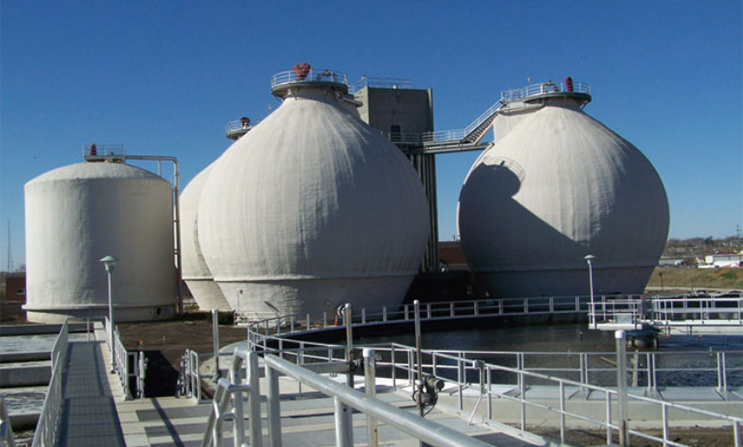
Data source: Lincoln, Nebraska government (copyrighted)
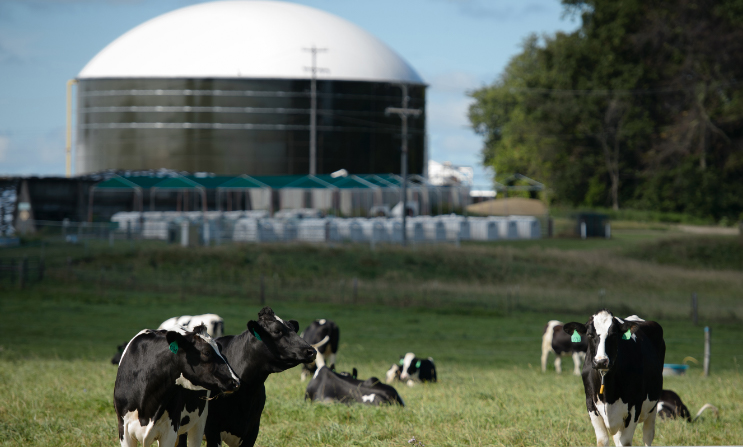
Data source: Michigan State University (copyrighted)
In the United States, regulations under the Clean Air Act require municipal-solid-waste landfills of a certain size to install and operate a landfill gas collection and control system. Some landfills reduce landfill gas emissions by capturing and burning—or flaring—the landfill gas. Burning the methane in landfill gas produces CO2, but CO2 is not as strong a greenhouse gas as methane. Many landfills collect landfill gas, treat it to remove CO2, water vapor, and hydrogen sulfide, and then sell the methane. Some landfills use the methane gas to generate electricity.
Biogas from sewage and industrial wastewater treatment
Many municipal sewage treatment plants and manufacturers such as paper mills and food processors use anaerobic digesters as part of their waste treatment processes. Some sewage treatment and industrial facilities collect and use the biogas produced in anaerobic digesters to heat the digesters, which enhances the anaerobic digestion process and destroys pathogens, and some use it to generate electricity to use at the facility or to sell.
Using biogas from animal waste
Some dairy farms and livestock operations use anaerobic digesters to produce biogas from manure and used bedding material from their barns. Some livestock farmers cover their manure holding ponds (also called manure lagoons) to capture biogas that forms in the lagoons. The methane in the biogas can be burned to heat water and buildings and as fuel in diesel-engine generators to generate electricity for the farm.
Biomass & the environment
Using biomass for energy has positive and negative effects
Biomass and biofuels made from biomass are alternative energy sources to fossil fuels—coal, petroleum, and natural gas. Burning either fossil fuels or biomass releases carbon dioxide (CO2), a greenhouse gas. However, the plants that are the source of biomass capture a nearly equivalent amount of CO2 through photosynthesis while they are growing, which can make biomass a carbon-neutral energy source.
Burning wood
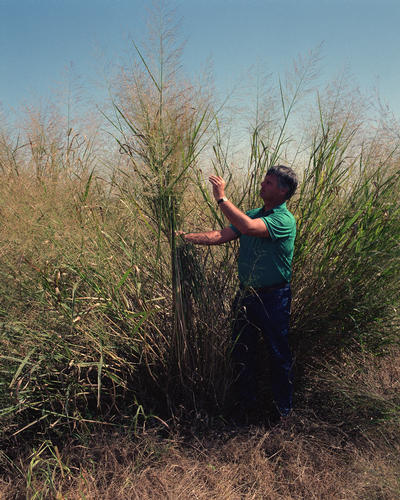
Data source: Wikimedia Commons (public domain)
Using wood, wood pellets, and charcoal for heating and cooking can replace fossil fuels and may result in lower CO2 emissions overall. Wood can be harvested from forests, from woodlots that have to be thinned, or from urban trees that fall down or have to be cut down.
Wood smoke contains harmful pollutants such as carbon monoxide and particulate matter. Modern wood-burning stoves, pellet stoves, and fireplace inserts can reduce the amount of particulates from burning wood. Wood and charcoal are major cooking and heating fuels in poor countries, but if people harvest the wood faster than trees can grow, it causes deforestation. Planting fast-growing trees for fuel and using fuel-efficient cooking stoves can help slow deforestation and improve the environment.
Burning municipal solid waste (MSW) or wood waste
Burning municipal solid waste (MSW) or garbage in waste-to-energy plants could result in less waste buried in landfills. On the other hand, burning garbage produces air pollution and releases the chemicals and substances in the waste into the air. Some of these chemicals can be hazardous to people and the environment if they are not properly controlled.
The U.S. Environmental Protection Agency (EPA) applies strict environmental rules to waste-to-energy plants, which require waste-to-energy plants to use air pollution control devices such as scrubbers, fabric filters, and electrostatic precipitators to capture air pollutants.
Scrubbers spray a liquid into waste-to-energy gases produced from burning waste to neutralize acids in the gases. Fabric filters and electrostatic precipitators also remove particles from the gases. The particles—called fly ash—are mixed with the ash that is removed from the bottom of the waste-to-energy furnace.
A waste-to-energy furnace burns at high temperatures (1,800°F to 2,000°F), so it can break down the chemicals in MSW into simpler, less harmful compounds.
Disposing ash from waste-to-energy plants
Ash from waste-to-energy plants can contain high concentrations of various metals that were present in the garbage. Textile dyes, printing inks, and ceramics, for example, may contain lead and cadmium.
Separating waste before burning can solve part of the problem. Because batteries are the largest source of lead and cadmium in municipal waste, they should not be included in regular trash. Florescent light bulbs should also not be put in regular trash because they contain small amounts of mercury.
The EPA tests ash from waste-to-energy plants to make sure that it is not hazardous. The EPA tests for chemicals and metals that could contaminate ground water. Some MSW landfills use ash the EPA considers safe as a cover layer for their landfills. Some MSW ash is used to make concrete blocks and bricks.
Collecting landfill gas or biogas
Biogas, which may be referred to as renewable natural gas forms as a result of biological processes in sewage treatment plants, waste landfills, and livestock manure management systems. Biogas is composed mainly of methane (a greenhouse gas) and CO2. Many facilities that produce biogas capture it and burn the methane for heat or to generate electricity. This electricity is considered renewable and, in many states, contributes to meeting state renewable portfolio standards (RPS). This electricity may replace electricity generation from fossil fuels and can result in a net reduction in CO2 emissions. Burning methane produces CO2, but because methane is a stronger greenhouse gas than CO2, the overall greenhouse effect is lower.
Liquid biofuels: ethanol and biodiesel
Biofuels are transportation fuels such as ethanol and biodiesel. The federal government promotes biofuels as transportation fuels to help reduce oil imports and CO2 emissions. In 2007, the U.S. government set a target to use 36 billion gallons of biofuels by 2022. As a result, nearly all gasoline now sold in the United States contains some ethanol.
Biofuels may be carbon-neutral because the plants that are used to make biofuels (such as corn and sugarcane for ethanol and soy beans and oil palm trees for biodiesel) absorb CO2 as they grow and may offset the CO2 emissions when biofuels are produced and burned.
Growing plants for biofuels is controversial because the land, fertilizers, and energy for growing biofuel crops could be used to grow food crops instead. In some parts of the world, large areas of natural vegetation and forests have been cut down to grow sugar cane for ethanol and soybeans and oil palm trees for biodiesel. The U.S. government supports efforts to develop alternative sources of biomass that do not compete with food crops and that use less fertilizer and pesticides than corn and sugar cane. The U.S. government also supports methods to produce ethanol that require less energy than conventional fermentation. Ethanol can also be made from waste paper, and biodiesel can be made from waste grease and oils and even algae.
Ethanol and gasoline-ethanol blends burn cleaner and have higher octane ratings than pure gasoline, but they have higher evaporative emissions from fuel tanks and dispensing equipment. These evaporative emissions contribute to the formation of harmful, ground-level ozone and smog. Gasoline requires extra processing to reduce evaporative emissions before it is blended with ethanol. Biodiesel combustion produces fewer sulfur oxides, less particulate matter, less carbon monoxide, and fewer unburned and other hydrocarbons, but it does produce more nitrogen oxide than petroleum diesel.


